Classification of Surface Water Using Machine Learning Methods from Landsat Data in Nepal †
Abstract
:1. Introduction
2. Materials and Methods
2.1. Case Study
2.2. Method
3. Results and Discussion
4. Conclusions
Conflicts of Interest
References
- Khanal, N.R.; Chalise, S.R.; Pokhrel, A.P. Ecohydrology of river basins of Nepal, Ecohydrology of High Mountain Areas. In Proceedings of the International Conference on Ecohydrology of High Mountain Areas, ICIMOD, Kathmandu, Nepal, 24–28 March 1996; Chalise, S.R., Ed.; ICIMOD: Kathmandu, Nepal, 1996; pp. 49–61. [Google Scholar]
- WECS. Water Resources of Nepal in the Context of Climate Change; Water and Energy Commission Secretariat, Goverment of Nepal: Kathmandu, Nepal, 2011.
- Bhuju, U.R.; Khadka, M.; Neupane, P.K.; Adhikari, R. Lakes of Nepal: 5358-A Map Based Inventory; Ministry of Tourism and Civil Aviation, Government of Nepal: Kathmandu, Nepal, 2009.
- Acharya, T.D.; Yang, I.T.; Subedi, A.; Lee, D.H. Change Detection of Lakes in Pokhara, Nepal Using Landsat Data. Proceedings 2017, 1, 17. [Google Scholar]
- Acharya, T.D.; Subedi, A.; Yang, I.T.; Lee, D.H. Combining Water Indices for Water and Background Threshold in Landsat Image. Proceedings 2018, 2, 143. [Google Scholar]
- Acharya, T.D.; Lee, D.H.; Yang, I.T.; Lee, J.K. Identification of Water Bodies in a Landsat 8 OLI Image Using a J48 Decision Tree. Sensors 2016, 16, 1075. [Google Scholar] [CrossRef]
- Acharya, T.D.; Subedi, A.; Lee, D.H. Evaluation of Water Indices for Surface Water Extraction in a Landsat 8 Scene of Nepal. Sensors 2018, 8, 2580. [Google Scholar] [CrossRef] [PubMed]


| S. No. | Machine Learning Methods | Overall Accuracy |
|---|---|---|
| 1 | Random Forest | 1.00 |
| 2 | Recursive Partitioning Tree | 0.950 |
| 3 | Support Vector Machine | 0.926 |
| 4 | Neural Network | 0.956 |
© 2018 by the authors. Licensee MDPI, Basel, Switzerland. This article is an open access article distributed under the terms and conditions of the Creative Commons Attribution (CC BY) license (https://creativecommons.org/licenses/by/4.0/).
Share and Cite
Acharya, T.D.; Subedi, A.; Huang, H.; Lee, D.H. Classification of Surface Water Using Machine Learning Methods from Landsat Data in Nepal. Proceedings 2019, 4, 43. https://doi.org/10.3390/ecsa-5-05833
Acharya TD, Subedi A, Huang H, Lee DH. Classification of Surface Water Using Machine Learning Methods from Landsat Data in Nepal. Proceedings. 2019; 4(1):43. https://doi.org/10.3390/ecsa-5-05833
Chicago/Turabian StyleAcharya, Tri Dev, Anoj Subedi, He Huang, and Dong Ha Lee. 2019. "Classification of Surface Water Using Machine Learning Methods from Landsat Data in Nepal" Proceedings 4, no. 1: 43. https://doi.org/10.3390/ecsa-5-05833
APA StyleAcharya, T. D., Subedi, A., Huang, H., & Lee, D. H. (2019). Classification of Surface Water Using Machine Learning Methods from Landsat Data in Nepal. Proceedings, 4(1), 43. https://doi.org/10.3390/ecsa-5-05833








